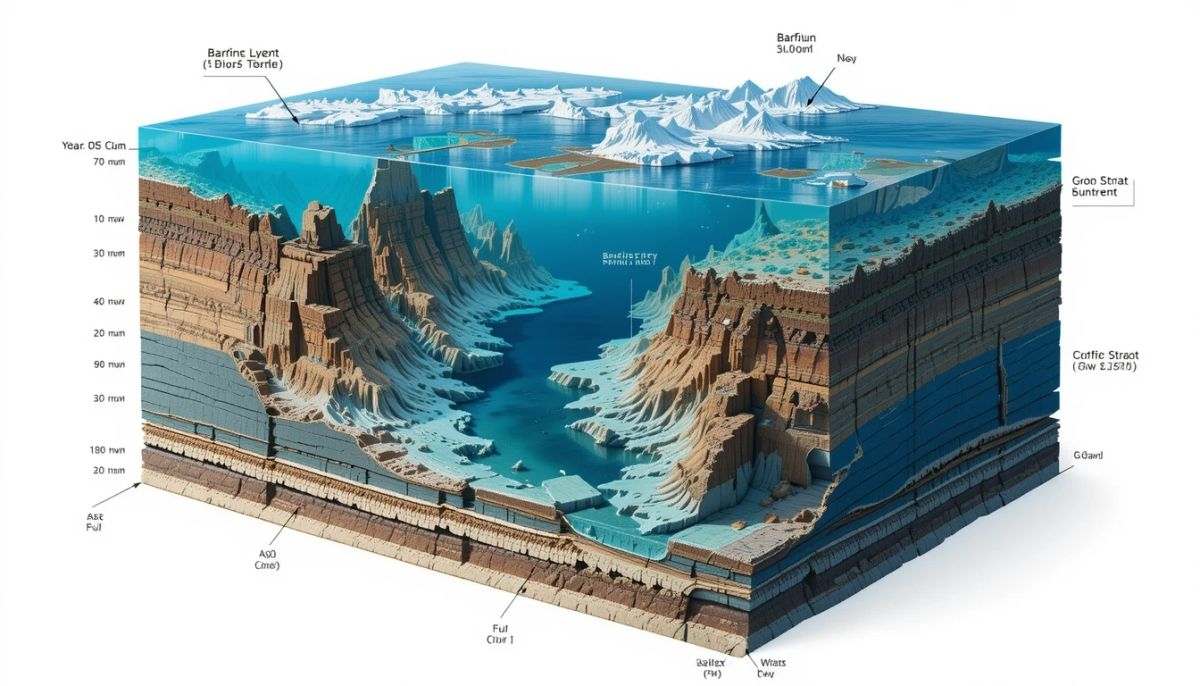In a groundbreaking discovery, geologists have identified a new microcontinent hidden beneath the waters between southeastern Baffin Island and southwestern Greenland. This submerged landmass, dubbed the Davis Strait proto-microcontinent, offers fascinating insights into Earth's tectonic history and the formation of microcontinents worldwide. Let's dive deep into this remarkable find and explore its implications for our understanding of plate tectonics and continental evolution.
What is the Davis Strait Proto-Microcontinent?
The Davis Strait proto-microcontinent is a fragment of continental crust approximately 400 kilometers (250 miles) long, with a thickness ranging from 19 to 24 kilometers. It lies submerged in the Davis Strait, which connects the Labrador Sea and Baffin Bay. This geological feature is surrounded by two narrow bands of thinner continental crust, effectively isolating it from the mainland of Greenland and Baffin Island.
The Formation Process
The birth of this microcontinent is a testament to the dynamic nature of Earth's crust. Its formation can be traced back to a series of tectonic events spanning millions of years:
- Initial Rifting: The process began about 118 million years ago during the Lower Cretaceous period when the landmass started to break away from Greenland.
- Seafloor Spreading: Approximately 61 million years ago, seafloor spreading commenced, marking a significant phase in the separation of landmasses.
- Tectonic Shift: The critical phase occurred between 58 and 49 million years ago when the direction of seafloor spreading between Canada and Greenland shifted from northeast-southwest to north-south. This change in orientation was instrumental in cleaving off the Davis Strait proto-microcontinent.
- Final Formation: The process concluded around 33 million years ago when seafloor spreading ceased due to Greenland's collision with Ellesmere Island, joining it to the North American plate.
Scientific Significance
The discovery of the Davis Strait proto-microcontinent is more than just a geological curiosity. It serves as a natural laboratory for studying the formation of microcontinents and offers valuable insights into plate motion changes and geological processes. Here's why this find is so significant:
- Understanding Microcontinent Formation: This well-preserved example provides a clear picture of how microcontinents can form, potentially shedding light on similar structures worldwide.
- Plate Tectonic Insights: The well-defined plate motion changes in this region make it an ideal case study for understanding how tectonic forces shape Earth's crust over millions of years.
- Continuous Continental Separation: Researchers suggest that each earthquake could contribute to future continental divisions, implying that microcontinent formation is an ongoing process.
- Implications for Disaster Prevention: Studying the formation of microcontinents like the Davis Strait proto-microcontinent may help in understanding and potentially mitigating tectonic hazards.
Global Comparisons
The Davis Strait proto-microcontinent is not alone in the world of submerged landmasses. Several other microcontinents have been discovered across the globe, each with its unique formation history:
- Zealandia: Often called Earth's "hidden continent," Zealandia is a vast submerged landmass in the Pacific Ocean that separated from Antarctica and Australia about 85 million years ago.
- Mauritia: Located beneath the Indian Ocean near Mauritius, this microcontinent formed during the breakup of Gondwana approximately 84 million years ago.
- Kerguelen Plateau: Found in the southern Indian Ocean, this large igneous province includes fragments of continental crust and formed through volcanic activity around 100 million years ago.
These examples highlight the diversity of microcontinent formation processes and underscore the complexity of Earth's tectonic history.
Research Methodology
The identification of the Davis Strait proto-microcontinent was made possible through advanced geological techniques:
- Seismic Reflection: This method allowed researchers to map the subsurface structure of the ocean floor.
- Gravity Data Analysis: By measuring minute variations in gravitational pull, scientists could infer the density and thickness of the crust.
- Plate Tectonic Reconstruction: Researchers created a detailed reconstruction of plate movements spanning approximately 30 million years to understand the formation process.
Implications for Future Research
The discovery of the Davis Strait proto-microcontinent opens up new avenues for geological research:
- Exploration of Similar Structures: This find may prompt the search for other hidden microcontinents in unexplored regions of the world's oceans.
- Refined Plate Tectonic Models: The detailed history of this microcontinent's formation could lead to more accurate models of plate tectonic movements.
- Resource Exploration: Understanding the formation of such structures could have implications for discovering new mineral and hydrocarbon resources.
- Climate Studies: Microcontinents can influence ocean currents and climate patterns, making this discovery potentially significant for climate research.
Conclusion
The identification of the Davis Strait proto-microcontinent is a remarkable achievement in the field of geology. It not only enhances our understanding of Earth's tectonic history but also provides a unique opportunity to study the processes that shape our planet's surface. As research continues, this submerged landmass may yield even more insights into the complex dance of continents that has been ongoing for billions of years.
FAQs
How was the Davis Strait proto-microcontinent discovered?
It was identified using advanced techniques such as seismic reflection and gravity data analysis by geologists from Uppsala University and the University of Derby.
How old is the Davis Strait proto-microcontinent?
The main formation process occurred between 49 and 58 million years ago, with initial rifting beginning about 118 million years ago.
Is the Davis Strait proto-microcontinent visible above water?
No, it is entirely submerged beneath the waters between southeastern Baffin Island and southwestern Greenland.
How does this discovery impact our understanding of plate tectonics?
It provides a clear example of microcontinent formation, helping scientists better understand the processes of continental breakup and plate motion changes.
Are there other microcontinents like this one?
Yes, other examples include Zealandia in the Pacific Ocean, Mauritia in the Indian Ocean, and the Kerguelen Plateau in the southern Indian Ocean.
